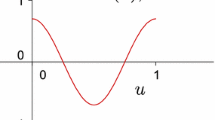Abstract
The paper deals with the H ∞ deconvolution fixed-lag smoothing problem for a linear timeinvariant discrete-time system with both known and unknown input series. The H ∞ fixed-lag smoother is derived by proposing a new approach termed as re-organized innovation analysis in Krein space. Under the new approach, it is clearly shown that the central deconvolution smoother in an H ∞ setting is the same as the one in an H 2 setting associated with one self-constructed stochastic state-space model. This insight allows us to calculate the complicated H ∞ deconvolution smoother in an intuitive and simple way. The deconvolution smoother is calculated by performing Riccati equation with the same order as the original system.
Similar content being viewed by others
References
N. Ott and H. G. Meder, “The Kalman filter as a prediction error filter,” Geophysical Rospecting, vol.20, pp. 549–560, 1972.
G. Tadmor and L. Mirkin, “H ∞ control and estimation with preview — part II: matrix ARE solutions in discrete-time,” IEEE Trans. Autom. Control, vol. 50, no. 1, pp. 29–39, January 2005.
T. C. Hanshaw, M. J. Anderson, and C. S. Hsu, “An H ∞ deconvolution filter and its application to ultrasonic nondestructive evaluation of materials,” ISA Trans., vol. 38, pp. 2891–2895, 1999.
M. J. Grimble, “H ∞ optimal multichannel linear deconvolution filters, predictors and smoothers,” Int. J. Contr., vol. 63, no. 3, pp. 519–533, 1996.
Z. Deng, H. Zhang, S. Liu, and L. Zhou, “Optimal and self-tuning white noise estimators with applications to deconvolution and filtering problems,” Automatica, vol. 32, no. 2, pp. 199–216, 1996.
H. Zhang, L. Xie, and Y. C. Soh, “H ∞ deconvolution deconvolution filtering, prediction, and smoothing: a Krein space poloynominal approach,” IEEE Trans. Automat. Contr., vol. 48, no. 3, pp. 888–892, 2000.
L. Chisci and E. Mosca, “Polynomial equations for the linear MMSE state estimation,” IEEE Trans. Autom. Control, vol. AC-37, no. 5, pp. 623–626, May 1992.
L. Xie, S. Wang, C. Du, and C. Zhang, “H ∞ deconvolution of periodic channels,” Signal Processing, vol. 80, pp. 2365–2378, 2000.
S. Wang, L. Xie, and C. Zhang, “Mixed H2/H ∞ deconvolution of uncertain periodic FIR channels,” Signal Processing, vol. 81, pp. 2089–2103, 2001.
X. Lu, H. Zhang, W. Wang, and J. Yan, “H ∞ deconvolution filtering: a Krein space approach in statespace setting,” J. Control Theory and Application, vol. 7, no. 2, pp. 185–191, 2009.
X. Lu, H. Zhang, W. Wang, and K. L. Teo, “Kalman filtering for multiple time-delay systems,” Automatica, vol. 41, no. 8, pp. 1455–1461, 2005.
H. Zhang and D. Zhang, “Finite horizon H ∞ fixedlag smoothing for time-varying continuous systems,” IEEE Trans. on Circuits and Systems Part II, vol. 51, no. 9, pp. 496–499, 2004.
X. Lu, H. Zhang, W. Wang, and C. Zhang, “H ∞ white-noise fixed-lag smoothing for discrete-time systems,” Proc. the American Control Conference, USA, pp. 5644–5649, 2006.
Author information
Authors and Affiliations
Corresponding author
Additional information
Recommended by Editorial Board member Poo Gyeon Park under the direction of Editor Young Il Lee. This work was supported by the National Nature Science Foundation of China (60804034,90920305,60772055), ‘973’ Program (2006CB705506). The work was also supported by the “National Outstanding Youth Foundation” (60825304) and the Nature Science Foundation of Shandong Province (Y2007G34).
Xiao Lu received his B.S. degree from the College of Electron and Information, Dalian Jiaotong University in 1998 and his Ph.D. degree from Dalian University of Technology in 2008. Currently, he is a teacher in Shandong University of Science and Technology. His interests include optimal estimation and control, robust filtering and control, and timedelay systems.
Huanshui Zhang graduated in Mathematics from the Qufu Normal University in 1986 and received his M.Sc. and Ph.D. degrees in Control Theory and Signal Processing from the Heilongjiang University, PR China, and Northeastern University, PR China, in 1991 and 1997, respectively. Currently he is a professor of Shandong University, and is an Associate Editor of IEEE Transactions on Circuits and Systems I.
Jie Yan obtained his Bachelor in Application Physics from Shandong University of Science and Technology, China, in 2007. He is presently toward to a master degree of Shandong University of Science and Technology, China.
Rights and permissions
About this article
Cite this article
Lu, X., Zhang, H. & Yan, J. On the H ∞ deconvolution fixed-lag smoothing. Int. J. Control Autom. Syst. 8, 896–902 (2010). https://doi.org/10.1007/s12555-010-0424-0
Received:
Revised:
Accepted:
Published:
Issue Date:
DOI: https://doi.org/10.1007/s12555-010-0424-0




